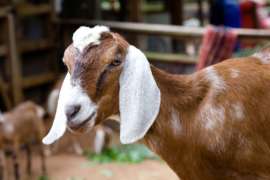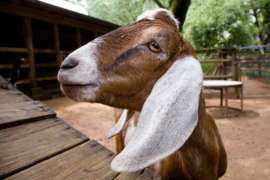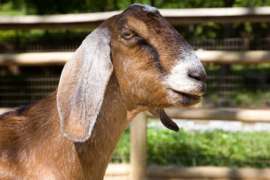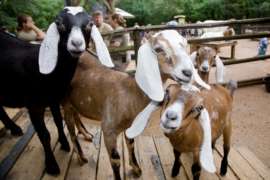Nubian Goat
Nubian Goat
This breed was developed in England when British goats crossed with bucks of African and Indian origin. Goats were among one of the very first domesticated animals, and they have been part of human life as companions and sources of hides and food for millennia. Many thousands of years of selective breeding have produced a large of number of breeds specialized for different purposes and climates.
Capra aegagrus hircus
Herbivore
Europe [VIEW MAP]
Urban Areas
Contact yard animals always have access to a quiet time area when they need a break from human affection. Guests may enjoy time with the animals anytime except during the coldest or rainiest conditions, but it will always be a surprise to find which specific breeds and individual animals are there to greet them.
Photos and Videos
The matriarch is the true leader of the group, and her dominance is determined by how many offspring she produces. Nubian goats create a group hierarchy by engaging in rearing and head-butting to establish dominance. They emit a high-pitched sneezing sound and stomp one forefoot if alarmed. Their milk has an unusually high percentage of butter fat, around 5 percent, and is often used to make cheese.
The Nubian goat’s coat is short and fine with a glossy appearance. They can be either solid in color or multicolored, usually black, red, or tan. A mature female stands at least 30 inches at the withers (top of the shoulder blades) and weighs 135 pounds or more. Males stand at least 35 inches at the withers and weigh at least 175 pounds. These goats have a distinctly raised, rounded nose in profile.
These goats live about 10 years, with sexual maturity reached by 3 to 12 months of age. Breeding season is in the fall, and the cycle of a doe lasts 17 to 23 days. Estrus lasts 12 to 48 hours. Gestation lasts 148 to 156 days and results in twins or even triplets.
Bucks smell to tell if a doe is in estrus by the behavior known as “flehmen.” In this behavior, they extend their necks and heads into the air and curl up their upper lips.
Contact yard animals always have access to a quiet time area when they need a break from human affection. Guests may enjoy time with the animals anytime except during the coldest or rainiest conditions, but it will always be a surprise to find which specific breeds and individual animals are there to greet them.
Nubian goats may also be referred to as Anglo-Nubian goats. This breed was developed in England when British goats crossed with bucks of African and Indian origin.
At the Zoo, we offer the goats a varied diet of Bermuda hay, browse (clippings from non-toxic plants across the Zoo), some grain and produce.





